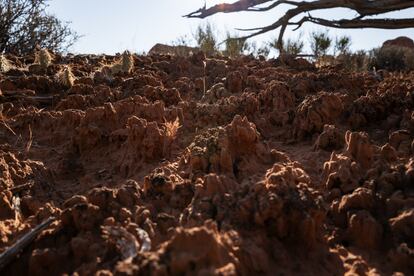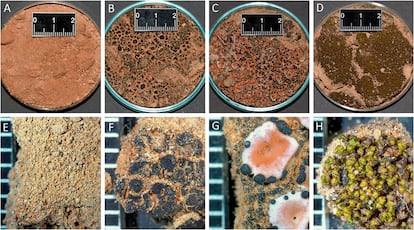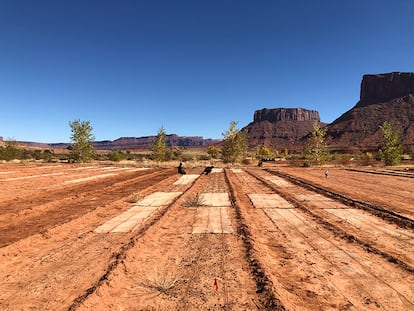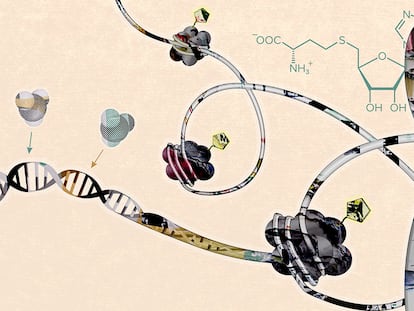The dirt on biocrusts: Why scientists are working to save Earth’s living skin
Think twice before stepping on that crunchy top layer of soil. It may be a vital ecosystem — one that you can help protect

Under the dry, piercing heat of the Utah sun, Sasha Reed is growing plots of plants — and bacteria, lichen and fungi, too. But Reed is no farmer, and at first glance, her fields look to be mostly dirt. She’s an ecologist, and what she is growing is cryptobiotic soil.
Also called biocrust, cryptobiotic soil is a community of tiny, dirt-dwelling organisms that form a distinct crust on the top of soil in arid landscapes. These crusts are vital across Earth’s dryland ecosystems, helping to hold loose soil together and prevent erosion. They retain water, provide nooks for other microbes to live in and add nitrogen to the soil.
Cryptobiotic soil often looks like a discolored patch of ground. Upon closer inspection, the stain becomes a mosaic of small, dark lumps, dotted with tiny beds of moss and inconspicuous patches of lichen. But it can also look very similar to regular, crusty soil. Although the crunchy earth might be tempting to trek over, like stomping through a pile of crisp autumn leaves, that’s a major faux pas: Biocrust can take decades to regenerate.

And these days, in addition to getting crushed by boots, biocrusts are threatened by another kind of human footprint: climate change. So researchers are diligently working to learn more about the crusts and how to restore them.
“It’s been a pretty busy but also exciting time, because we’re kind of inventing how to do this,” says Anita Antoninka, a plant and soil ecologist at Northern Arizona University in Flagstaff who studies the crusts.
The drylands where biocrusts reside are vital ecosystems, she says, but they are some of the most degraded around the globe. As biocrusts decline in these areas, soil fertility will drop and wind erosion will blow away the loose, unprotected dirt. Less water will soak into the ground. Even the carbon cycle could be affected, as there will be fewer tiny life forms absorbing carbon dioxide.
Itty-bitty communities
Biocrusts cover around 12 percent of Earth’s land surfaces and inhabit every continent in the world. A major component of these crusts is often photosynthesizing bacteria called cyanobacteria. The cyanobacteria form sticky filaments that act like glue in sandy desert soil, creating a clumpy, crusty surface where fungi and other bacteria take hold.
Depending on what environment a biocrust is in, it can also house itty-bitty mosses, lichens and microscopic algae. For example, in desert areas with more moisture, like Moab, Utah, biocrusts tend to feature mosses. In gypsum-rich soils, such as near Lake Mead, Nevada, lichens take center stage. Some crusts feature all components, and in other crusts, multiple components are missing. But regardless of their community lineup, the crusts all serve as a living skin for desert land.
“They provide this suit of armor to the soil,” says Ferran Garcia-Pichel, a microbiologist at Arizona State University in Tempe. When he first started working with biocrusts around two decades ago, very little was known about them. In the 2023 Annual Review of Microbiology, Garcia-Pichel outlines what researchers have learned about cryptobiotic soil over the last couple decades and what remains unknown.
“In these 25, 30 years, we’ve made so much progress,” he says.
One thing that several studies have shown is that increased warming and changes in rainfall pose a threat. Over the next 65 years, models suggest that climate change could slash 25 percent to 40 percent of biocrust cover. The crusts are sensitive to higher temperatures and to fluctuations in precipitation — both extended dry spells and unusual increases in rainfall can harm them, depending on their location.
To combat those declines, ecologists like Reed, of the United States Geological Survey in Moab, and her colleagues are trying to figure out how to regrow crusts in the wild.
In what she calls possibly the largest outdoor biocrust nursery in the world, Reed is focusing on three main facets of biocrust restoration. The first ingredient is learning what environment the crusts will grow best in — and also, importantly, transfer well from. Initially, researchers had huge success growing communities of biocrusts in indoor greenhouses. But their life was too cushy, Reed says. When transplanted outside, the crusts struggled to take hold. Some of the crusts now grow directly outside: “We’re trying to give them a stricter upbringing,” she says. In the outdoors, they experience far more realistic environmental conditions, although they still get a leg up from the team through watering and shade.
A second arm of Reed’s work at the biocrust farm is seeing how much of an intact community biocrusts need to thrive. Biocrust is totipotent, which means just a small piece of it can eventually give rise to new crust. Thus, one way of growing biocrusts in new areas is to crumble some up and sprinkle it on the landscape, similar to scattering seeds.
But in the wild, crust components could work positively together in unknown ways, so Reed wonders if biocrusts might benefit from being grown as larger, more established communities. “We put them out in these harsh environments, kind of alone, and say, ‘Live, thrive,’” she says. “We’re not seeing them do that as much as we would hope.”
That led researchers to try a new restoration method inspired by sod. First, they sprinkled biocrust crumbles onto weed cloth — a thin fabric used by landscapers. After the crust grew, they rolled it up and unrolled it at its final destination. To Reed’s surprise, the strategy worked. Though she had feared the rolls of crust would crumble apart, they stayed intact and grew well in their new surroundings. The method could be used in small, strategic spots like next to trails, but probably not on a landscape-wide scale.

In the third facet of Reed’s restoration research at the biocrust farm, the scientists want to know if there are particular biocrust community members that are better suited for restoration in the face of climate change. To do that, Reed and Antoninka took biocrusts from hotter, drier locations — a stand-in for what the Southwest’s drylands could look like in the future — and grew them back on the farm. Now, they’re monitoring how the crusts continue to grow post-transplant in restoration sites. As the crust develops, researchers will look for species, or sources of biocrust communities, that seem to do particularly well.
Reed, Antoninka and others are now partnering with land managers — including national parks, the Bureau of Land Management and the U.S. Forest Service — to apply what they’ve learned about biocrusts. “Partnerships are really, really important,” Antoninka says — the Moab nursery, for example, is a collaboration with Northern Arizona University, the Nature Conservancy and a local restoration nonprofit, Rim to Rim Restoration. And by working with land managers, Antoninka says, it’s possible to include biocrust restoration plans in future development projects that will disturb the soil.
People in arid regions can do the same in their own backyards. If property owners are planning a project that would tear up or build over soil that has a crust, they can simply salvage whatever crust is there then stick it in a bucket and keep it dry and cool, Antoninka says. Then they can sprinkle it back over the disturbed soil, or elsewhere on the property.
Other ways that the public can help to preserve biocrusts include staying on trails to avoid smashing them, and spreading the word about the crusts to raise awareness. If people don’t know biocrust is there, the tiny ecosystem beneath their feet is easy to overlook.
“Get down on hands and knees and just take a look,” Reed says. “We study them because of their importance, but their beauty and their coolness is also worth noting.”
This article originally appeared in Knowable Magazine, a non-profit publication dedicated to making scientific knowledge accessible to everyone.
Sign up for our weekly newsletter to get more English-language news coverage from EL PAÍS USA Edition
Tu suscripción se está usando en otro dispositivo
¿Quieres añadir otro usuario a tu suscripción?
Si continúas leyendo en este dispositivo, no se podrá leer en el otro.
FlechaTu suscripción se está usando en otro dispositivo y solo puedes acceder a EL PAÍS desde un dispositivo a la vez.
Si quieres compartir tu cuenta, cambia tu suscripción a la modalidad Premium, así podrás añadir otro usuario. Cada uno accederá con su propia cuenta de email, lo que os permitirá personalizar vuestra experiencia en EL PAÍS.
¿Tienes una suscripción de empresa? Accede aquí para contratar más cuentas.
En el caso de no saber quién está usando tu cuenta, te recomendamos cambiar tu contraseña aquí.
Si decides continuar compartiendo tu cuenta, este mensaje se mostrará en tu dispositivo y en el de la otra persona que está usando tu cuenta de forma indefinida, afectando a tu experiencia de lectura. Puedes consultar aquí los términos y condiciones de la suscripción digital.
More information

These proteins have been secretly managing your cells

New generation of radioactive drugs strike cancer with molecular precision
Archived In
Últimas noticias
Sydney Sweeney, the actress praised by Trump: ‘Women are up against what society wants them to be’
The Bolsonaro surname: An advantage or liability in Brazil’s 2026 presidential elections?
Raúl Rocha, from jet-setting with Miss Universe to arms trafficking and fuel theft
80,000 barrels of Mexican oil sent to Cuba: Havana drawn into the US–Mexico clash
Most viewed
- Reinhard Genzel, Nobel laureate in physics: ‘One-minute videos will never give you the truth’
- Pablo Escobar’s hippos: A serious environmental problem, 40 years on
- Charles Dubouloz, mountaineering star, retires at 36 with a farewell tour inspired by Walter Bonatti
- Why we lost the habit of sleeping in two segments and how that changed our sense of time
- The fall of a prolific science journal exposes the billion-dollar profits of scientific publishing








































